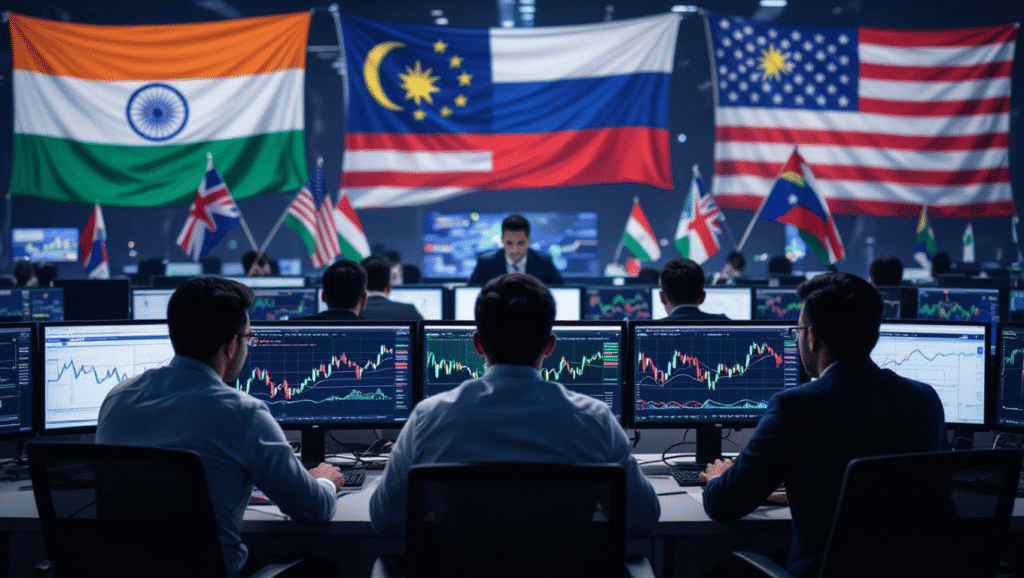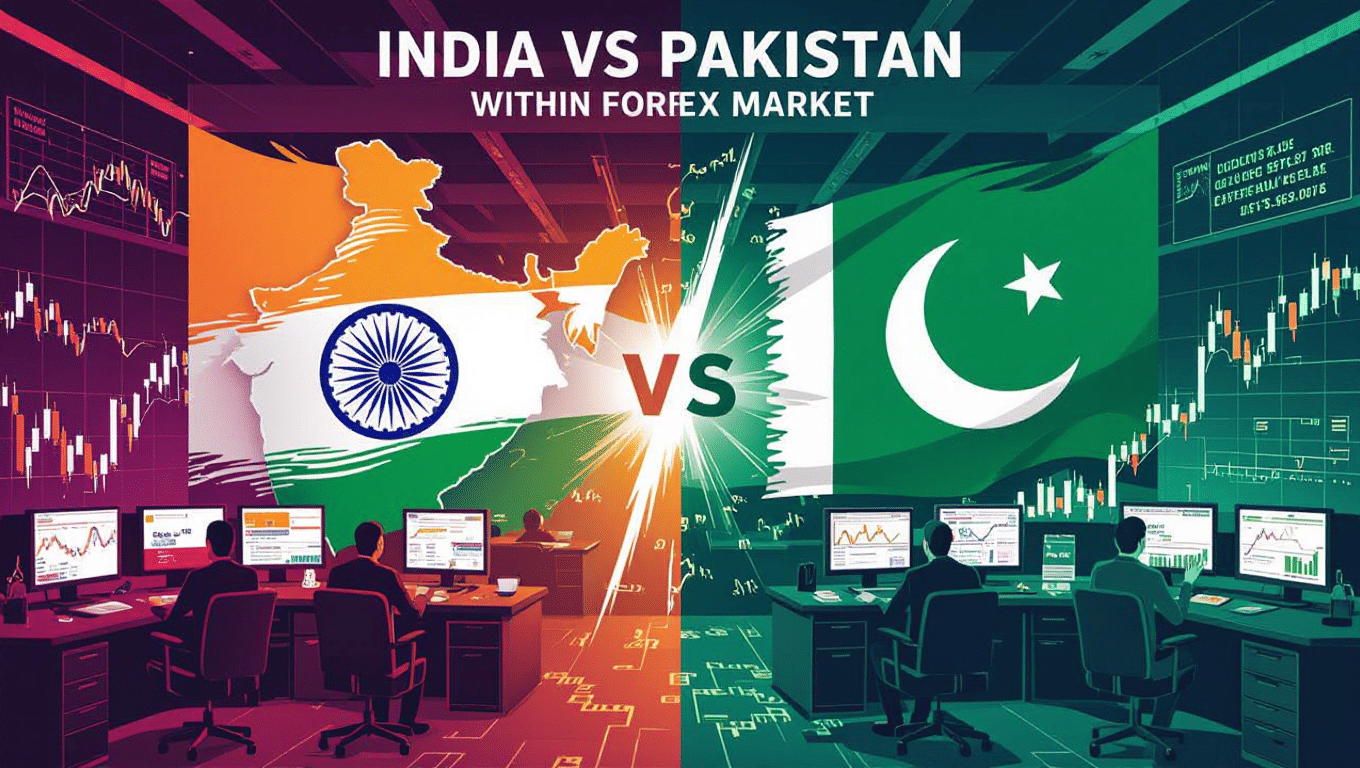Introduction
Geopolitical tensions often cast a long shadow over global finance, with the India-Pakistan Conflict being a prominent example. This enduring geopolitical issue has significant implications for the Forex Market, influencing everything from currency volatility to investment strategies. The recent Pahalgam attack, where security forces encountered militants in a tragic skirmish, has heightened tensions again, making it imperative for traders and investors to understand the broader economic and market dynamics at play.
Understanding the India-Pakistan Conflict: A Historical and Current Perspective

The origins of the India-Pakistan Conflict trace back to the 1947 partition of British India, leading to the formation of India and Pakistan. Kashmir became the main flashpoint, resulting in several wars and ongoing tension.
Historical Milestones
- First Indo-Pakistani War (1947-1948): This conflict set the stage for future disputes over Kashmir.
- Kargil Conflict (1999): Marked by military engagements, it caused significant ripples in global financial markets, including oil price spikes and currency volatility.
- Mumbai Attacks (2008): Demonstrated the profound impact of terrorism on bilateral relations and global markets, creating significant turbulence in the financial sectors.
Current Developments: The Pahalgam Attack
The recent attack in Pahalgam has refocused global attention on the region, escalating tensions and impacting market stability. This incident highlights the fragile nature of peace between India and Pakistan, affecting investor confidence and economic forecasts.
Forex Market Impact: Immediate and Long-term Effects
Immediate Currency Volatility
The Forex Market reacts quickly to geopolitical events like the Pahalgam attack:
- INR and PKR Volatility: Both the Indian Rupee (INR) and the Pakistani Rupee (PKR) often experience immediate depreciation against the US Dollar, reflecting increased political risk.
- Investor Caution: Heightened tensions typically lead investors to seek safer assets, contributing to capital outflows from emerging markets in South Asia.
- Potential Stabilization: If diplomatic efforts successfully ease tensions, we may see a stabilization and potential appreciation of these currencies.
Long-term Economic Consequences
While immediate effects are pronounced, the economic impact extends further:
- Foreign Direct Investment and Growth: Prolonged tensions deter FDI, crucial for economic growth, as investors seek stable environments with lower political risks.
- Government Fiscal Policies: Increased defense spending often diverts funds from development projects, affecting long-term economic health and policy planning.
Broader Economic Repercussions: Analyzing the Ripple Effect
The India-Pakistan Conflict extends its impact beyond immediate market reactions, affecting various economic dimensions:
Trade and Commerce

- Impact on Bilateral Trade: Tensions can disrupt cross-border trade, affecting businesses reliant on imports and exports between the two nations.
- Regional Economic Stability: Neighboring economies in the South Asian Association for Regional Cooperation (SAARC) also feel the effects, influencing regional trade agreements and economic outlooks.
Business and Consumer Confidence
- Sector-specific Impacts: Industries such as tourism, particularly in areas like Pahalgam, experience downturns following increased hostilities.
- Consumer Sentiment: Prolonged uncertainty can dampen consumer confidence, affecting spending habits and economic growth.
Learning from History to Guide Current Strategies

Historical responses to conflicts between India and Pakistan offer insights for current financial strategies:
Case Studies: Historical Context
- Kargil Conflict: Triggered temporary spikes in oil prices and heightened demand for gold as a safe-haven asset, showcasing market sensibilities to geopolitical tensions.
- Mumbai Attacks: Led to sharp currency fluctuations, reflecting the market’s sensitivity to terrorist activities and their implications.
- Uri Attack (2016): Increased defense expenditures strained fiscal resources, highlighting the complex interplay between security needs and economic stability.
Understanding historical market responses assists traders and investors in forming effective investment strategies in the current geopolitical climate.
Crafting Trading Strategies: Navigating Geopolitical Uncertainties
Unpredictable geopolitical tensions require carefully crafted investment strategies focusing on risk management and adaptability.
Tactical Approaches for Traders
- Portfolio Diversification: Spread investments across various assets and regions to mitigate risk and maintain portfolio stability amidst currency volatility.
- Hedging Techniques: Use currency futures, options, and other derivatives to protect against adverse currency movements, securing investments against unforeseen volatility.
- Short-term Opportunities: Volatile markets offer lucrative opportunities for scalping or swing trading, although these require careful execution and risk management.
Long-term Investment Considerations
Investors should focus on:
- Geo-economic Analysis: Factor political risk into portfolio management, recognizing global trends and their potential long-term impacts.
- Policy Monitoring: Stay updated on policy changes and diplomatic developments that could influence market sentiments.
Risk Management: Preparing for Geopolitical Uncertainty

Effective risk management is essential for navigating the complexities of global markets affected by the India-Pakistan Conflict.
Proactive Risk Management
- Continuous Monitoring: Vigilantly track geopolitical news and economic indicators affecting market stability and currency trends.
- Scenario Planning: Develop contingency plans for escalating or de-escalating tensions, ensuring portfolio readiness for various outcomes.
Maintaining Discipline
- Emotional Resilience: In volatile markets, maintaining composure is critical. Avoid impulsive decisions driven by short-term movements.
- Financial Goals: Clearly defined financial objectives help focus on long-term growth, navigating short-term geopolitical instability.
Final Thoughts: Harnessing Opportunities Amid Challenges
The interplay between geopolitics and the Forex Market is a reality that investors must navigate. The India-Pakistan Conflict, amplified by recent incidents like the Pahalgam attack, underscores the importance of understanding these dynamics.
By leveraging historical insights, developing robust investment strategies, and maintaining adaptable risk management practices, investors can protect their assets and identify opportunities in volatility. Proactive planning and continuous education are key to transforming geopolitical challenges into strategic advantages.
At Giraffe Markets, we remain committed to providing in-depth analysis and expert guidance to help you navigate the complexities of the global financial market landscape. Stay informed with our updates and insights to enhance your trading decisions amidst the ever-evolving geopolitical environment.
